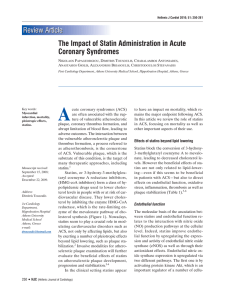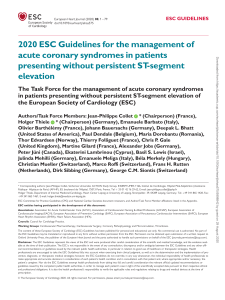Reduction in Acute Myocardial Infarction Mortality Over a Five
Anuncio
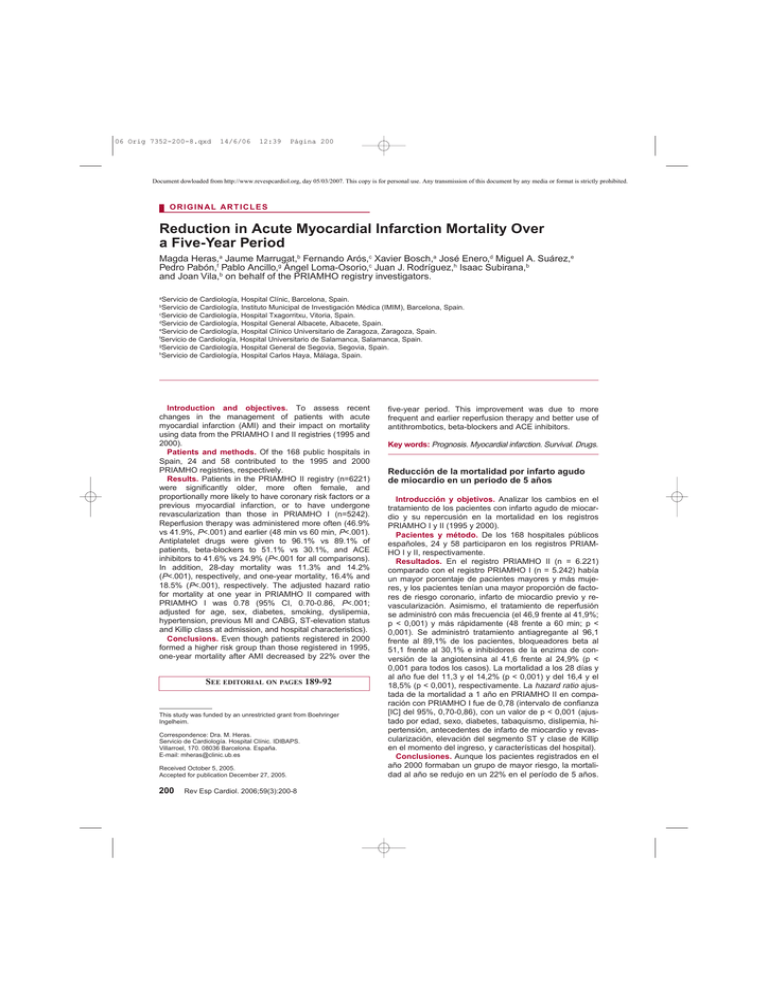
06 Orig 7352-200-8.qxd 14/6/06 12:39 Página 200 Document dowloaded from http://www.revespcardiol.org, day 05/03/2007. This copy is for personal use. Any transmission of this document by any media or format is strictly prohibited. ORIGINAL ARTICLES Reduction in Acute Myocardial Infarction Mortality Over a Five-Year Period Magda Heras,a Jaume Marrugat,b Fernando Arós,c Xavier Bosch,a José Enero,d Miguel A. Suárez,e Pedro Pabón,f Pablo Ancillo,g Ángel Loma-Osorio,c Juan J. Rodríguez,h Isaac Subirana,b and Joan Vila,b on behalf of the PRIAMHO registry investigators. a Servicio de Cardiología, Hospital Clínic, Barcelona, Spain. Servicio de Cardiología, Instituto Municipal de Investigación Médica (IMIM), Barcelona, Spain. c Servicio de Cardiología, Hospital Txagorritxu, Vitoria, Spain. d Servicio de Cardiología, Hospital General Albacete, Albacete, Spain. e Servicio de Cardiología, Hospital Clínico Universitario de Zaragoza, Zaragoza, Spain. f Servicio de Cardiología, Hospital Universitario de Salamanca, Salamanca, Spain. g Servicio de Cardiología, Hospital General de Segovia, Segovia, Spain. h Servicio de Cardiología, Hospital Carlos Haya, Málaga, Spain. b Introduction and objectives. To assess recent changes in the management of patients with acute myocardial infarction (AMI) and their impact on mortality using data from the PRIAMHO I and II registries (1995 and 2000). Patients and methods. Of the 168 public hospitals in Spain, 24 and 58 contributed to the 1995 and 2000 PRIAMHO registries, respectively. Results. Patients in the PRIAMHO II registry (n=6221) were significantly older, more often female, and proportionally more likely to have coronary risk factors or a previous myocardial infarction, or to have undergone revascularization than those in PRIAMHO I (n=5242). Reperfusion therapy was administered more often (46.9% vs 41.9%, P<.001) and earlier (48 min vs 60 min, P<.001). Antiplatelet drugs were given to 96.1% vs 89.1% of patients, beta-blockers to 51.1% vs 30.1%, and ACE inhibitors to 41.6% vs 24.9% (P<.001 for all comparisons). In addition, 28-day mortality was 11.3% and 14.2% (P<.001), respectively, and one-year mortality, 16.4% and 18.5% (P<.001), respectively. The adjusted hazard ratio for mortality at one year in PRIAMHO II compared with PRIAMHO I was 0.78 (95% CI, 0.70-0.86, P<.001; adjusted for age, sex, diabetes, smoking, dyslipemia, hypertension, previous MI and CABG, ST-elevation status and Killip class at admission, and hospital characteristics). Conclusions. Even though patients registered in 2000 formed a higher risk group than those registered in 1995, one-year mortality after AMI decreased by 22% over the SEE EDITORIAL ON PAGES 189-92 This study was funded by an unrestricted grant from Boehringer Ingelheim. Correspondence: Dra. M. Heras. Servicio de Cardiología. Hospital Clínic. IDIBAPS. Villarroel, 170. 08036 Barcelona. España. E-mail: [email protected] Received October 5, 2005. Accepted for publication December 27, 2005. 200 Rev Esp Cardiol. 2006;59(3):200-8 five-year period. This improvement was due to more frequent and earlier reperfusion therapy and better use of antithrombotics, beta-blockers and ACE inhibitors. Key words: Prognosis. Myocardial infarction. Survival. Drugs. Reducción de la mortalidad por infarto agudo de miocardio en un período de 5 años Introducción y objetivos. Analizar los cambios en el tratamiento de los pacientes con infarto agudo de miocardio y su repercusión en la mortalidad en los registros PRIAMHO I y II (1995 y 2000). Pacientes y método. De los 168 hospitales públicos españoles, 24 y 58 participaron en los registros PRIAMHO I y II, respectivamente. Resultados. En el registro PRIAMHO II (n = 6.221) comparado con el registro PRIAMHO I (n = 5.242) había un mayor porcentaje de pacientes mayores y más mujeres, y los pacientes tenían una mayor proporción de factores de riesgo coronario, infarto de miocardio previo y revascularización. Asimismo, el tratamiento de reperfusión se administró con más frecuencia (el 46,9 frente al 41,9%; p < 0,001) y más rápidamente (48 frente a 60 min; p < 0,001). Se administró tratamiento antiagregante al 96,1 frente al 89,1% de los pacientes, bloqueadores beta al 51,1 frente al 30,1% e inhibidores de la enzima de conversión de la angiotensina al 41,6 frente al 24,9% (p < 0,001 para todos los casos). La mortalidad a los 28 días y al año fue del 11,3 y el 14,2% (p < 0,001) y del 16,4 y el 18,5% (p < 0,001), respectivamente. La hazard ratio ajustada de la mortalidad a 1 año en PRIAMHO II en comparación con PRIAMHO I fue de 0,78 (intervalo de confianza [IC] del 95%, 0,70-0,86), con un valor de p < 0,001 (ajustado por edad, sexo, diabetes, tabaquismo, dislipemia, hipertensión, antecedentes de infarto de miocardio y revascularización, elevación del segmento ST y clase de Killip en el momento del ingreso, y características del hospital). Conclusiones. Aunque los pacientes registrados en el año 2000 formaban un grupo de mayor riesgo, la mortalidad al año se redujo en un 22% en el período de 5 años. 06 Orig 7352-200-8.qxd 14/6/06 12:39 Página 201 Document dowloaded from http://www.revespcardiol.org, day 05/03/2007. This copy is for personal use. Any transmission of this document by any media or format is strictly prohibited. Heras M et al. Reduction in Acute Myocardial Infarction Mortality ABBREVIATIONS ECG: electrocardiogram. AMI: acute myocardial infarction. ACEI: angiotensin converting enzyme inhibitors. PRIAMHO: Proyecto de Registro de Infarto de Miocardio Hospitalario (Acute Myocardial Infarction Hospital Registry Project). CCU: coronary care unit. Los factores causantes de esta mejoría son la administración más rápida y frecuente de tratamiento de reperfusión y un mayor uso de fármacos antitrombóticos, bloqueadores beta e inhibidores de la enzima de conversión de la angiotensina. Palabras clave: Pronóstico. Infarto de miocardio. Supervivencia. Fármacos. INTRODUCTION Clinical practice guidelines for acute myocardial infarction (AMI) are periodically updated1,2 and it is important to assess how these recommendations are incorporated in day-to-day clinical practice.3 The changes introduced have been analyzed on a large scale in Europe, the USA, and other regions3,4; however, differences in the economy, structure, and health-care organization of different countries make it necessary to perform these evaluations at a national level.5-10 Mortality due to AMI is directly related to early reperfusion of the ischemic myocardium. Therefore, it is particularly important to assess variations in the rate of reperfusion over time. Although myocardial reperfusion can be achieved by thrombolysis, better results are achieved with primary angioplasty; however, the organizational requirements of the latter procedure are more complex. Since these treatments are less effective if they are not administered early, it is important to avoid unnecessary delays, either outside or within the hospital. On the other hand, it is also necessary to evaluate the administration of other treatments that improve shortterm and long-term survival. The Proyecto de Registro de Infarto de Miocardio Hospitalario (Acute Myocardial Infarction Hospital Registry Projects; PRIAMHO) I and II collected data on the treatment of AMI in Spain for 1 year in 1995 and 7 months in 2000, respectively.6,9 Substantial changes in treatment were introduced during that 5-year period. Consequently, comparison of the 2 registries will allow us to measure those changes and determine whether the prognosis of patients with AMI changed in the intervening period. The aims of this study were to assess the variations in the percentage of reperfused patients, evaluate changes in the delay between the onset of symptoms and reperfusion therapy, and analyze the use of the various diagnostic and therapeutic options, as well as their impact on 28-day and 1-year mortality. PATIENTS AND METHODS The PRIAMHO registries, designed by the Spanish Society of Cardiology Working Group on Ischemic Heart Disease and Coronary Care Units to assess variability in the treatment of AMI in Spain, were undertaken in 1995 and 2000. The methods used have been published previously.6,9 Of the 168 public hospitals in Spain with a coronary care unit (CCU), 47 agreed to participate in the 1995 study (PRIAMHO I) and 81 in the 2000 study (PRIAMHO II). In PRIAMHO II, the hospitals were randomly selected, while in PRIAMHO I they were selected by the scientific committee. All hospitals had to meet the following criteria: a) register at least 70% of the patients admitted to the hospital with AMI (coverage); b) register more than 75% of the patients with AMI admitted to the CCU (completeness); c) achieve a concordance (kappa statistic) of more than 70% between the data registered and those obtained by an external auditor in a random sample of 15% of the patients registered in each hospital; and d) complete 1-year follow-up in more than 90% of registered patients. All patients with AMI admitted to the CCU were consecutively registered between October 1994 and September 1995, and between May 15 and December 16, 2000. Diagnosis of AMI was based on the presence of at least 2 of the following criteria: appearance of Q waves, elevation of cardiac enzyme levels (more than twice the upper limit of the normal range), and typical chest pain for more than 20 minutes.6,9 Data were collected on demographic variables, clinical history and complications, and the diagnostic procedures and therapies used. The following were considered indicators of the quality of drug treatment used in the CCU: thrombolysis, beta-blockers, antiplatelet drugs, and angiotensin converting enzyme inhibitors (ACEI). Patient follow-up was performed by outpatient appointment or telephone interview. All-cause mortality was registered. Statistical Analysis Continuous variables are shown as mean±SD and discrete variables as percentages. The differences between the 2 registries were analyzed using the χ2 test in the case of discrete variables and the Student t test or the Mann-Whitney test for continuous variables. The differences in the number of dead and surviving patients were assessed using the hazard ratio in a Cox proportional hazards model. Mortality at 28 days and 1 year were analyzed through multilevel logistic and Cox proportional hazards models, with patient data as the first level and hospital data as the second. Rev Esp Cardiol. 2006;59(3):200-8 201 06 Orig 7352-200-8.qxd 14/6/06 12:39 Página 202 Document dowloaded from http://www.revespcardiol.org, day 05/03/2007. This copy is for personal use. Any transmission of this document by any media or format is strictly prohibited. Heras M et al. Reduction in Acute Myocardial Infarction Mortality Three adjusted models were generated for each follow-up period. Each model included variables that differed between the 2 periods studied with a P value of less than <0.10 in the univariate analysis and, in addition, were associated with 1-year mortality. Both individual data (demographic variables, comorbidity, and clinical characteristics) and hospital data (number of beds, presence of a CCU or intensive care unit, catheterization laboratory) were used. Model 1 also contained severity measured by, among others, Killip class. Model 2 also included treatment with antiplatelet drugs and delay between the onset of symptoms and reperfusion categorized into 4 levels: less then <3 hours, 3 to 6 hours, more than >12 hours, or not performed. Finally, the third model also included treatment with beta-blockers and ACEI. RESULTS The percentage of invited hospitals whose responses met the required quality criteria was 51% (24 out of 47 hospitals) and 72% (58 out of 81 hospitals) in PRIAMHO I and II, respectively. Hospitals that initiated patient selection but did not meet the quality criteria of PRIAMHO I and II (9 and 14 hospitals, respectively) were excluded from the final analysis. A total of 5242 and 6221 patients were included in PRIAMHO I and II, respectively. In PRIAMHO I, 50% of the participating hospitals had a catheterization laboratory whereas in PRIAMHO II this figure was 43%. The quality variables for PRIAMHO I and II, respectively, were as follows: completeness, 94% and 96%; coverage, 78% and 87%; and 1-year follow-up, 96% and 93%. The number of patients included in the study according to the characteristics of the hospital in PRIAMHO I and II is shown in Table 1. The patients in PRIAMHO I were treated more often in CCUs in medium-sized hospitals. There were no statistically significant differences in the number of patients admitted to hospitals with catheterization laboratories. Clinical Characteristics Compared with PRIMAHO I, PRIAMHO II included a higher percentage of older patients, women, and patients with coronary risk factors or prior coronary artery revascularization. ST-segment elevation was presented by 72% of patients in PRIAMHO I and 69.4% of patients in PRIAMHO II (P=.003). Table 2 also shows the percentage of patients with a Q wave in the electrocardiogram (ECG) performed at the time of discharge and the proportion with anterior infarction. Treatment Overall, reperfusion therapy was performed in 2198 (41.9%) and 2810 (45.2%) patients in PRIAMHO I and II, respectively. Primary angioplasty was the reperfusion 202 Rev Esp Cardiol. 2006;59(3):200-8 TABLE 1. Number of Patients Admitted According to the Characteristics of the Hospitals Participating in the PRIAMHO Registries in 1995 and 2000* Coronary care unit Catheterization laboratory Size of hospital <200 beds 200-500 beds >500 beds PRIAMHO I (n=5242) PRIAMHO II (n=6221) 4198 (80.1%) 4256 (68.4%) <.001 3175 (60.6%) 3673 (59.0%) .101 364 (6.9%) 1002 (19.1%) 3876 (73.9%) 229 (3.7%) 1621 (26.1%) 4371 (70.3%) <.001 P *Data are shown as number (%). TABLE 2. Demographic and Comorbidity Variables, Risk Factors, and Clinical Characteristics of the Patients Included in the PRIAMHO Registries in 1995 and 2000* PRIAMHO I (n=5242) Age, mean±SD, years 64.4±12.20 Women 1184 (22.6%) Cardiovascular risk factors Diabetes 1271 (24.2%) Smoking 1969 (37.6%) Dyslipidemia 1499 (28.6%) Hypertension 2223 (42.4%) Prior coronary artery disease Myocardial infarction 915 (17.5%) CABG/PTCA 186 (3.5%) ECG at admission ST-segment elevation/LBBB 3770 (71.9%) Q wave at discharge 3744 (74.3%) Anterior infarction 2199 (42.0%) PRIAMHO II (n=6221) P 65.4±12.76 1571 (25.3%) <.001 .001 1824 (29.4%) 2732 (44.1%) 2497 (40.3%) 2859 (46.1%) <.001 <.001 <.001 <.001 974 (15.7%) 523 (8.5%) .013 <.001 4271 (69.4%) 4038 (65.6%) 2661 (43.2%) .003 <.001 .201 *Data are shown as number (%) unless otherwise indicated. CABG indicates coronary artery bypass graft; PTCA, percutaneous transluminal coronary angioplasty; ECG, electrocardiogram; LBBB, left bundle branch block. therapy in 323 patients (5.4%) and rescue reperfusion (with a second thrombolysis or rescue angioplasty) was performed in 3.1% of patients in PRIAMHO II (Table 3). Compared with PRIAMHO I, the patients in PRIAMHO II were less likely to receive streptokinase (8.4% vs 19.2%) but more likely to receive rt-PA (23.7% vs 20.6%) and other thrombolytics (9.4% vs 2.2%). The time between the onset of symptoms, arrival in the emergency department, and reperfusion was similar in both registries. The door-to-needle time was reduced by 12 minutes; the mean door-to-balloon time for patients treated by angioplasty in PRIAMHO II was 82 minutes. 06 Orig 7352-200-8.qxd 14/6/06 12:39 Página 203 Document dowloaded from http://www.revespcardiol.org, day 05/03/2007. This copy is for personal use. Any transmission of this document by any media or format is strictly prohibited. Heras M et al. Reduction in Acute Myocardial Infarction Mortality TABLE 3. Reperfusion and Intervals, Other Treatments, and Diagnostic and Therapeutic Procedures During Period of Admission in the Coronary Care Unit in the PRIAMHO Registries in 1995 and 2000* PRIAMHO I (n=5242) Reperfusion Thrombolysis Primary angioplasty Delays, median (range)†, min Symptom onset to arrival in emergency department Onset of symptoms to beginning of reperfusion Door-to-needle time Drug treatment Antiplatelet drugs Unfractionated heparin Low molecular weight heparin Beta-blockers ACEI Oral nitrates Intravenous nitrates Calcium channel blockers Diagnostic and therapeutic procedures Coronary angiography Echocardiography in the CCU Swan-Ganz catheter Intraaortic balloon pump 2198 (41.9%) 0 135 (61-300) 180 (120-265) 60 (30-95) PRIAMHO II (n=6221) 2487 (40%) 323 (5.2%) 140 (63-324) 170 (115-260) 48 (30-77) P .659 .016 .494 .406 <.001 4669 (89.1%) 3428 (65.4%) – 1579 (30.1%) 1306 (24.9%) 1704 (32.5%) 3798 (72.5%) 809 (15.4%) 5916 (96.3%) 3332 (55.1%) 3023 (50.0%) 3134 (51.1%) 2555 (41.6%) 2015 (33.9%) 4281 (72.0%) 588 (9.6%) <.001 <.001 457 (8.7%) 2109 (40.2%) 327 (6.2%) 44 (0.8%) 747 (12.4%) 2064 (34.1%) 199 (3.3%) 80 (1.3%) <.001 <.001 <.001 .014 <.001 <.001 .125 .572 <.001 *Data are shown as number (%) unless otherwise indicated. ACEI indicates angiotensin converting enzyme inhibitors; CCU, coronary care unit. †For patients who received reperfusion treatment. There was a significant increase in the administration of aspirin, low-molecular-weight heparin, beta-blockers, and ACEI, and a significant reduction in the administration of intravenous heparin and calcium channel blockers. In PRIAMHO II, 86.9% of the patients received fractionated or unfractionated heparin, compared with only 65.4% of patients in PRIAMHO I. Table 3 also shows the use of diagnostic and therapeutic procedures. There was a significant increase in the use of coronary angiography and intraaortic balloon pumps, and a reduction in the use of echocardiography and Swan-Ganz catheters in the CCU. TABLE 4. Mortality and Complications in the Patients Included in the PRIAMHO Registries in 1995 and 2000* PRIAMHO I (n=5242) Mortality At 28 days At 1 year Complications Worse Killip class during period of admission I II III IV Reinfarction Post-AMI angina Ventricular fibrillation Ventricular tachycardia Atrioventricular block Atrial fibrillation/flutter Mechanical complications PRIAMHO II (n=6221) 744 (14.2%) 972 (18.5%) 705 (11.3%) 1023 (16.4%) 3648 (69.8%) 707 (13.5%) 425 (8.1%) 446 (8.5%) 168 (3.2%) 529 (10.1%) 273 (5.2%) 429 (8.2%) 289 (5.5%) 476 (9.1%) 177 (3.4%) 4262 (69.5%) 817 (13.3%) 473 (7.7%) 582 (9.5%) 139 (2.3%) 566 (9.4%) 312 (5.2%) 179 (3.0%) 379 (6.3%) 487 (8.1%) 158 (2.6%) P <.001 <.001 .307 .004 .221 .964 <.001 .077 .06 .02 *Data are shown as number (%). AMI indicates acute myocardial infarction. Rev Esp Cardiol. 2006;59(3):200-8 203 06 Orig 7352-200-8.qxd 14/6/06 12:39 Página 204 Document dowloaded from http://www.revespcardiol.org, day 05/03/2007. This copy is for personal use. Any transmission of this document by any media or format is strictly prohibited. Heras M et al. Reduction in Acute Myocardial Infarction Mortality A 28-Day Follow-Up 1.0 Cumulative Survival 0.8 0.6 0.4 0.2 PRIAMHO-I PRIAMHO-II 0.0 0 5 10 15 20 25 30 Time, Days B 1-Year Follow-Up 1.0 Cumulative Survival 0.8 0.6 0.4 0.2 PRIAMHO-I PRIAMHO-II 0.0 0 100 200 Time, Days Mortality Mortality at 28 days and 1 year was significantly reduced between 1995 and 2000: from 14.2% to 11.3% and from 18.5% to 16.4%, respectively. This reduction occurred without changes in the proportion of patients in Killip class III and IV (Table 4). There were significantly fewer instances of reinfarction, ventricular tachycardia, and mechanical complications in the patients included in PRIAMHO II (Table 4). Figures 1A and 1B show the 204 Rev Esp Cardiol. 2006;59(3):200-8 300 Figure. A) Kaplan-Meier survival curve (28 days) for PRIAMHO I and II (P<.001). B) Kaplan-Meier survival curve (1 year) for PRIAMHO I and II (P=.037). Kaplan-Meier survival curves at 28 days and 1 year for patients in both registries. Table 5 shows the determinants of 1-year mortality in both registries. Mortality was correlated with, among others, prior history of diabetes, hypertension, previous infarction, age, female sex, anterior infarction, and Killip class III and IV. Coronary reperfusion and administration of antiplatelet drugs, beta-blockers, and ACEI significantly reduced mortality. Mortality was also reduced by reperfusion within 6 hours of the onset of 06 Orig 7352-200-8.qxd 14/6/06 12:39 Página 205 Document dowloaded from http://www.revespcardiol.org, day 05/03/2007. This copy is for personal use. Any transmission of this document by any media or format is strictly prohibited. Heras M et al. Reduction in Acute Myocardial Infarction Mortality TABLE 5. Determinants of 1-Year Mortality in Patients From the PRIAMHO Registries for 1995 and 2000* Survivors (n=9468) Cardiovascular risk factors Diabetes Hypertension Smoking Dyslipidemia Previous myocardial infarction Clinical Characteristics Age, mean±SD, years Women Previous coronary surgery Delay from onset of symptoms, median (range), min ST-segment elevation at admission Anterior MI Q wave Killip class III-IV Reinfarction Post-MI angina Procedures and treatments Thrombolysis/PCI Antiplatelet drugs Beta-blockers ACEI Calcium channel blockers Coronary angiography Time to reperfusion† <3 hours ≥3 hours and <6 hours ≥6 hours and <12 hours No reperfusion or delay ≥12 hours Hospital characteristics Catheterization laboratory Coronary care unit Hospital size <200 beds 200-500 beds >500 beds Deaths During the First Year (n=1995) 2359 (25.0%) 4088 (43.3%) 4208 (44.5%) 3451 (36.5%) 1417 (15.0%) 736 (36.9%) 994 (49.9%) 493 (24.7%) 545 (27.4%) 472 (23.7%) Hazard Ratio (95% CI) 1.65 (1.51-1.81) 1.26 (1.15-1.37) 0.44 (0.40-0.49) 0.68 (0.61-0.75) 1.64 (1.48-1.81) 63.3±12.4 2061 (21.8%) 180 (2.0%) 170 (120-255) 6658 (70.8%) 3867 (41.1%) 6482 (69.8%) 777 (8.3%) 170 (1.8%) 889 (9.6%) 72.6±10.1 693 (34.7%) 54 (2.7%) 195 (120-300) 1382 (69.4%) 993 (49.9%) 1299 (68.0%) 1148 (57.8%) 137 (6.9%) 206 (10.4%) 1.07±1.06-1.07 1.83 (1.67-2.01) 1.36 (1.04-1.79) 1.08 (1.05-1.12) 0.95 (0.86-1.05) 1.39 (1.27-1.53) 0.94 (0.85-1.03) 10.45 (9.55-11.43) 3.13 (2.63-3.72) 1.05 (0.91-1.22) 4349 (46.2%) 8929 (95.0%) 4350 (46.3%) 3257 (34.7%) 1213 (12.9%) 992 (10.7%) 659 (33.1%) 1656 (83.3%) 363 (18.3%) 604 (30.4%) 184 (9.3%) 212 (10.7%) 0.61 (0.55-0.67) 0.29 (0.26-0.33) 0.28 (0.25-0.32) 0.81 (0.74-0.89) 0.69 (0.59-0.81) 1.00 (0.86-1.15) 1971 (22.0%) 1433 (16.0%) 419 (4.7%) 5152 (57.4%) 226 (11.9%) 225 (11.8%) 94 (4.9%) 1354 (71.3%) 0.47 (0.41-0.54) 0.63 (0.55-0.73) 0.88 (0.72-1.09) Ref.‡ 5638 (59.6%) 6999 (73.9) 1209 (60.6%) 1454 (72.9) 1.03 (0.94-1.13) 095 (0.86-1.05) 508 (5.4%) 2194 (23.2%) 6765 (71.5%) 85 (4.3%) 429 (21.5%) 1481 (74.2%) Ref.‡ 1.14 (0.91-1.44) 1.24 (0.99-1.54) *Data are shown as number (%) unless otherwise indicated. CI indicates confidence interval; PCI, percutaneous coronary intervention; ACEI, angiotensin converting enzyme inhibitors; MI, myocardial infarction. †For patients who receive reperfusion treatment. ‡The hazard ratios for previous groups take this group as a reference. symptoms compared with reperfusion after 6 hours. Calcium channel blockers displayed a positive association with reduced mortality in the univariate analysis but the effect was not significant in the multivariate analysis. Hospital variables were not predictive of mortality. Following adjustment for the variables described in Table 6, there was a 22% reduction in the risk of mortality at 1 year for patients in the PRIAMHO II study. Upon adjustment for antiplatelet drugs, reperfusion, and delay in reperfusion, the reduction in the risk was 13%. When beta-blockers and ACEI were incorporated in the model, no further reduction in the risk was observed (Table 6). Similar results were obtained for 28-day mortality (Table 6). DISCUSSION This study reveals a reduction of 22% in the 1-year mortality between patients admitted to Spanish hospitals in 1995 and those admitted in 2000. The reduction is independent of differences between patients or the characteristics of the hospitals. The 2000 cohort included a greater percentage of older patients, patients with higher comorbidity, and women than those selected in 1995. The reduced mortality was apparent at 28 days and persisted to 1 year. The difference in mortality may be explained by an overall improvement in the treatment of patients with AMI, particularly the increased use of antithrombotic drugs, the higher rate of reperfusion, and Rev Esp Cardiol. 2006;59(3):200-8 205 06 Orig 7352-200-8.qxd 14/6/06 12:39 Página 206 Document dowloaded from http://www.revespcardiol.org, day 05/03/2007. This copy is for personal use. Any transmission of this document by any media or format is strictly prohibited. Heras M et al. Reduction in Acute Myocardial Infarction Mortality TABLE 6. Adjusted Hazard Ratios for 28-Day and 1-Year Mortality in Patients Included in the PRIAMHO II Registry in 2000 Compared With Those Included in the PRIAMHO I Registry in 1995* Mortality at 28 Days Model 1 Model 2 Model 3 Mortality at 1 Year Model 4 Model 5 Model 6 OR 95% CI 0.61 0.77 0.89 0.52-0.72 0.60-0.83 0.74-1.06 HR 95% CI 0.78 0.87 1 0.70-0.86 0.78-0.97 0.89-1.12 P <.001 <.001 .187 P <.001 .001 .960 *HR indicates hazard ratio; CI, confidence interval; OR, odds ratio. Model 1: adjusted for age, sex, hypertension, diabetes, smoking, dyslipidemia, previous myocardial infarction, previous coronary surgery or percutaneous coronary intervention, ST-segment elevation at admission, Killip class at admission, coronary care unit, catheterization laboratory, size of hospital, HOSPITAL (random effects factor). Model 2: adjusted as for model 1 plus antiplatelet drugs and reperfusion, and delay of these therapies. Model 3: adjusted as in model 2 plus beta-blockers and angiotensin converting enzyme inhibitors. Model 4: adjusted as for model 1. Model 5: adjusted as for model 2. Model 6: adjusted as for model 3. the increase in the administration of beta-blockers and ACEI. Another factor that may have contributed to this reduction is the lower door-to-needle time in 2000 compared with the 1995 cohort.11 The percentage of patients treated with primary angioplasty in PRIAMHO II was low, a finding that is reflective of cardiology practice in Spain in 2000,3,8,9 when only a small number of hospitals could perform coronary interventions 24 hours a day; furthermore, at that time there were also no transport networks to move patients with AMI to hospitals where the procedure could be performed. Comparison With Other Registries The time between the onset of symptoms and admission to hospital remained stable in Spain over the 5-year period studied. Furthermore, it is very similar to that described in the registry performed by the Italian CCU network in 200112; the time between hospital admission and reperfusion (door-to-needle time) was almost identical (45 and 48 minutes for the Italian and Spanish registries, respectively). The Second National Registry of Myocardial Infarction also found that prehospital delays remained stable in the period from 1994 to 1997.13 The Medicare registry described a small reduction of 7 minutes during the same period in the USA.14 Despite the fact that the time elapsed prior to treatment did not display an overall reduction, the reduction in mortality observed in our study has also been described by researchers in other countries. The 206 Rev Esp Cardiol. 2006;59(3):200-8 main reason for the reduction in mortality between 1975 and 1995 was studied by Heidenreich et al15 based on a MEDLINE literature search of studies that analyzed the use of different therapies in AMI. They observed a 9.6% reduction in mortality at 30 days that was due to increased use of aspirin, reperfusion,16 beta-blockers, and ACEI; administration of these therapies explained 71% of the 30-day mortality adjusted for sex and age. Likewise, investigators in Worcester, USA, described increased use of betablockers and ACEI that was also linked to a reduction of in-hospital mortality.17 It is important to note that the proportion of patients who received beta-blockers and ACEI in Spain, although higher than in 1995, still needs to be improved, since it is well below that described in the Euro Heart Survey of Acute Coronary Syndromes,3 the MITRA and MIR registries,7 and in Switzerland,18 among others, as well as in relation to clinical practice guidelines.2 Finally, some population studies have also described a reduction in mortality in survivors of AMI over a 10year period. Researchers seem to agree that this reduction is directly related to a good transfer into day-to-day clinical practice of knowledge obtained in clinical surveys and increased use of reperfusion, antithrombotic agents, beta-blockers, and ACEI.19,20 Characteristics and Limitations of the Study Although more than 10% of Spanish hospitals participated in PRIAMHO I, that study was not as representative of the country as PRIAMHO II, in which the hospitals were chosen at random and in which a higher level of participation was achieved. However, the large number of patients included in each registry and the strict quality controls ensured that the patients with AMI were representative and that an excellent picture of clinical practice was obtained, in addition to an adequate statistical power for comparisons to be made between the 2 studies. Finally, the present study only analyzed treatments received following admission to the CCU; nevertheless, it is within the first few days of infarction that the majority of complications, including death, occur. Future Tasks The use of medical knowledge in clinical practice depends on various factors: improvements in hospital structure, education of doctors and patients, economic limitations, and health policies. Although the only improvement in the period prior to reperfusion was seen in the door-to-needle time, we are still some way from achieving an optimal time and further reductions need to be made. Delays between the onset of symptoms and arrival in the emergency department, and until reperfusion, did not change between 1995 06 Orig 7352-200-8.qxd 14/6/06 12:39 Página 207 Document dowloaded from http://www.revespcardiol.org, day 05/03/2007. This copy is for personal use. Any transmission of this document by any media or format is strictly prohibited. Heras M et al. Reduction in Acute Myocardial Infarction Mortality and 2000. Consequently, it would appear to be essential to develop a strategy that takes into account both education of the patient to seek medical help more rapidly and the organization of transport to the emergency department and coordination with the receiving hospital.21 Cardiologists must work closely with doctors in emergency services to ensure reperfusion within 30 minutes. Likewise, both the creation of chest pain clinics in city hospitals22,23 and prehospital fibrinolysis24,25 administered by welltrained teams would help to improve the treatment of patients suffering an AMI. The use of primary angioplasty will not be extensively implemented until a network of hospitals with appropriate experience is created along with adequate medical transport. In addition, this hospital network should connect rural and regional hospitals with tertiary hospitals and should also be able to offer more aggressive treatment in patients in Killip class III and IV. CONCLUSION The results of this study indicate that the risk of death during the first year following AMI was significantly reduced over a 5-year period. The reduced risk is correlated with an increase in the use of antithrombotic treatment, beta-blockers, and ACEI, and with a higher percentage of administration of early reperfusion therapy. ACKNOWLEDGMENTS We are grateful to all the doctors who selected patients in both registries; their names and affiliations are provided below. We would also like to acknowledge the expert secretarial support provided by Cristina Siles. PRIAMHO I investigators: F. Sogorb, J. Caturla, J.G. Martínez, J. Canovas, Hospital General Universitari d’Alacant, Alicante; D. Pereferrer, A. Curós, J. Serra, Hospital Germans Trias i Pujol, Badalona; X. Mancisidor, Hospital de Cruces, Baracaldo; X. Bosch, Institut de Malalties Cardiovasculars, Hospital Clínic, Barcelona; J. Bruguera, J. Illa, Hospital del Mar, Barcelona; M. García Moll, J.M. Domínguez de Rozas, J. Guindo, Hospital de Sant Pau, Barcelona; A.J. Montón, R. Giral, A. Santamaría, Hospital General Yagüe, Burgos; E. González, H. Boix, Hospital Gran Vía, Castellón; F. García de Burgos, A. Mota López, Hospital General de Elche, Elche; P. Orosa, J.M. Carmona, T. Orengo, Hospital Francesc de Borja, Gandía; L. López-Bescós, C. Kallmeyer, L. Melgares, Hospital Universitario Getafe, Getafe; R. Masiá, J. Sala, X. Albert, Hospital Josep Trueta, Girona; N. Alonso-Orcajo, R. García, J. Bayón, Complejo Hospitalario de León, León; E. Cereijo, R. Gabriel, Hospital de La Princesa, Madrid; M. de los Reyes, J. Alcázar, Instituto de Cardiología, Madrid; J. Rodríguez, Hospital 12 de Octubre, Madrid; E. Torrado, J.A. Ferriz, Hospital Regional de Málaga, Málaga; M. Fiol, J. Bergadá, Hospital de Son Dureta, Palma de Mallorca; R. Rodríguez Gil, Hospital de Requena, Requena; P. Pabón, Hospital Universitario de Salamanca, Salamanca; V. Bertomeu, A. Frutos, F. Colomina, Hospital Universitario de San Juan, San Juan; F. Marrero, M.J. García, L. Martí, Hospital Universitario de Canarias, Santa Cruz de Tenerife; J.M. Sanjosé, P. Colveé, Hospital Marqués de Valdecilla, Santander; M. Jaquet, Hospital Xeral de Galicia Gil Casares, Santiago de Compostela; J. Rojas, J. García-Rovira, J. Trujillo, Hospital Universitario Virgen Macarena, Sevilla; S. Quintana, M. Ibartz, I. Cherta, Hospital Mútua de Terrassa, Terrassa; J. Sánchez, L. Martos, Hospital Virgen del Valle, Toledo; R. Claramonte, L. Gabaldà, Hospital de Tortosa Verge de la Cinta, Tortosa; I. Echanove, J.V. Vilar, R. Tellols, Hospital General de Valencia, Valencia; A. Cabadés, I. Ceniceros, R. Gastaldo, M. Palencia, Hospital La Fe, Valencia; M. Francés, M. García, A. Hervás, L. Cortés, F. Fajarnés, Hospital Arnau de Vilanova, Valencia; J.J. Sanz, J.L. Bratos, P. Enríquez, Hospital del Río Hortega, Valladolid; J. Bermejo, M.M. de Latorre, L. de la Fuente, I. Garcimartín, Hospital Universitario de Valladolid, Valladolid; F. Arós, A. Loma, Hospital Txagorritxu, Vitoria; G. Hernando, Hospital de Galdácano, Vizcaya; J. Marrugat, M. Pavesi, Institut Municipal d’Investigació Mèdica, Barcelona. PRIAMHO II investigators: J. Enero, Hospital General de Albacete, Albacete; P. Cobo, Hospital Punta Europa, Algeciras; F. Sogorb, Hospital General Universitario, Alicante; G. Rey, Hospital San Agustín, Avilés; X. Mancisidor, Hospital de Cruces, Baracaldo; J. Figueras, Ciutat Sanitària Vall d’Hebron, Barcelona; X. Bosch, Hospital Clínic, Barcelona; A. Montón, Hospital General Yagüe, Burgos; E. González, Hospital Gran Vía, Castellón de la Plana; P. Marzal, Hospital Marina Alta y CE Denia, Denia; P. Marco, Hospital Nuestra Señora de Aránzazu, Donostia-San Sebastián; E. Escudero, Hospital Can Misses, Eivissa; Carmen J., Complejo Hospitalario Arquitecto Marcide, El Ferrol; J.A. Lapuerta, Hospital Cabueñes, Gijón; J. Sala, Hospital Universitario Josep Trueta, Girona; A. Reina, Hospital Universitario Virgen de las Nieves, Granada; P. Velasco, Hospital General de Granollers, Granollers; A. Carrillo, Hospital Princesa de España, Jaén; M. García, Hospital Universitario de Canarias, La Laguna; I. Ostobal, Hospital de la Línea, La Línea de la Concepción; V. Nieto, Complejo Hospitalario Materno-Insular, Las Palmas; A. Medina, Hospital Universitario Dr. Negrín, Las Palmas; F. del Nogal, Hospital Severo Ochoa, Leganés; F. Worner, Ciutat Sanitària de Bellvitge, L’Hospitalet de Llobregat; J. Cabau, Hospital Provincial de Santa María, Lleida; M. Piqué, Hospital Universitario Arnau de Vilanova, Lleida; O. Saornil, Complejo Hospitalario Xeral-Calde, Lugo; I. González, Hospital La Paz, Madrid; E. Torrado, Complejo Hospitalario Carlos Haya, Málaga; P. Galdós, Complejo Hospitalario Móstoles-Alcorcón, Móstoles; J.M. Mercado, Hospital General Básico, Motril; A. Carrillo, Hospital General J.M. Morales Messeguer, Murcia; A. Díaz, Complejo Hospitalario Ourensan Cristal-Piñor, Orense; E. Rodríguez, Complejo Hospitalario Santa María Nai-Cabaleiro, Orense; I. Sánchez, Hospital Central de Asturias, Oviedo; M. Fiol, Hospital Son Dureta, Palma de Mallorca; M.S. Alcasena, Hospital de Navarra, Pamplona; M. Rico, Hospital Militar Vázquez Bernabeu, Quart de Poblet; Pedro Massana, Hospital de Sant Joan, Reus; J.I. Mateo, Hospital General Básico Serrania, Ronda; V. Parra, Hospital de Sagunto, Sagunto; P. Pabón, Hospital Universitario de Salamanca, Salamanca; V. Rev Esp Cardiol. 2006;59(3):200-8 207 06 Orig 7352-200-8.qxd 14/6/06 12:39 Página 208 Document dowloaded from http://www.revespcardiol.org, day 05/03/2007. This copy is for personal use. Any transmission of this document by any media or format is strictly prohibited. Heras M et al. Reduction in Acute Myocardial Infarction Mortality Bertomeu, Hospital Universitari Sant Joan d’Alacant, Sant Joan d’Alacant; M. Nolla, Hospital General de Catalunya, Sant Cugat del Vallès; O. Martín, Hospital Residencia San Camilo, Sant Pere de Ribes; J.M. San José, Hospital Universitario Marqués de Valdecilla, Santander; M. Jaquet, Complejo Hospitalario Universitario, Santiago de Compostela; P. Ancillo, Hospital General de Segovia, Segovia; R. Claramonte, Hospital de Tortosa Verge de la Cinta, Tortosa; A. Bartolomés, Hospital San Juan de la Cruz, Úbeda; M. Francés, Hospital Arnau de Vilanova, Valencia; F. Valls, Hospital Doctor Peset, Valencia; I. Echanove, Hospital General Universitario de Valencia, Valencia; A. Cabadés, Hospital Universitario La Fe, Valencia; J. Bermejo, Hospital Universitario de Valladolid, Valladolid; C. Falces, Hospital General de Vic, Vic; M. Victoria, Hospital do Meixoeiro, Vigo; F. Noriega, Policlínico Vigo S.A. (POVISA), Vigo; F. Criado, Hospital del SVS de Villajoyosa, Villajoyosa; J.C. Sanz, Hospital Comarcal de Vinarós, Vinarós; A. Loma, Hospital Txagorritxu, Vitoria-Gasteiz; M.A. Suárez, Hospital Clínico Universitario Lozano Blesa, Zaragoza. REFERENCES 1. Arós F, Loma-Osorio A, Alonso A, Alonso JJ, Cabadés A, Coma-Canella I, et al. Guías de actuación clínica de la Sociedad Española de Cardiología en el infarto agudo de miocardio. Rev Esp Cardiol. 1999;52:919-56. 2. van de Werf F, Ardissino D, Betriu A, Cokkinos DV, Falk E, Fox KA, et al. Management of acute myocardial infarction in patients presenting with ST-segment elevation. The Task Force on the management of acute myocardial infarction of the European Society of Cardiology. Eur Heart J. 2003;24:28-66. 3. Hasdai D, Behar S, Wallentin L, Danchin N, Gitt AK, Boersma E, et al. A prospective survey of the characteristics, treatments and outcomes of patients with acute coronary syndromes in Europe and the Mediterranean basin; the Euro Heart Survey of Acute Coronary Syndromes (Euro Heart Survey ACS). Eur Heart J. 2002;23:1109-201. 4. Fox KA, Goodman SG, Klein W, Brieger D, Steg PG, Dabbous O, et al. Management of acute coronary syndromes. Variations in practice and outcome. Findings from the Global Registry of Acute Coronary Events (GRACE). Eur Heart J. 2002;23:1177-89. 5. Danchin N, Vaur L, Genes N, Renault M, Ferrieres J, Etienne S, et al. Management of acute myocardial infarction in intensive care units in 1995: a nationwide French survey of practice and early hospital results. J Am Coll Cardiol. 1997;30:1598-605. 6. Cabadés A, López-Bescos L, Arós F, Loma-Osorio A, Bosch X, Pabón P, et al. Variabilidad en el manejo y pronóstico a corto y medio plazo del infarto de miocardio en España: el estudio PRIAMHO. Rev Esp Cardiol. 1999;52:767-75. 7. Zahn R, Schiele R, Schneider S, Gitt AK, Wienbergen H, Seidl K, et al. Decreasing hospital mortality between 1994 and 1998 in patients with acute myocardial infarction treated with primary angioplasty but not in patients treated with intravenous thrombolysis. J Am Coll Cardiol. 2000;36:2064-71. 8. Rogers WJ, Canto JG, Lambrew CT, Tiefenbrunn AJ, Kinkaid B, Shoultz DA, et al. Temporal trends in the treatment of over 1.5 million patients with myocardial infarction in the U.S. from 1990 through 1999. The National Registry of Myocardial Infarction 1, 2 and 3. J Am Coll Cardiol. 2000;36:2056-63. 208 Rev Esp Cardiol. 2006;59(3):200-8 9. Arós F, Cuñat J, Loma-Osorio A, Torrado E, Bosch X, Rodríguez JJ, et al. PRIAMHO II Study. Tratamiento del infarto agudo de miocardio en España en el año 2000. El estudio PRIAMHO II. Rev Esp Cardiol. 2003;56:1165-73. 10. Kaul P, Newby LK, Fu Y, Mark DB, Califf RM, Topol EJ, et al. International differences in evolution of early discharge after acute myocardial infarction. Lancet. 2004;363:511-7. 11. Ancillo P, Bosch X, Loma-Osorio A, Pabón P, Rodríguez JJ, Arós F, et al. Factores asociados al uso de la reperfusión en pacientes con infarto agudo de miocardio y elevación del segmento ST en España: Proyecto de Registro del Infarto agudo de Miocardio en Hospitales (PRIAMHO II). Med Int. 2003;27:653-61. 12. di Chiara A, Chiarella F, Savonitto S, Lucci D, Bolognese L, de Servi S, et al. Epidemiology of acute myocardial infarction in the Italian CCU network: the BLITZ study. Eur Heart J. 2003;24:1616-29. 13. Goldberg RJ, Gurwitz JH, Gore JM. Duration of, and temporal trends (1994-1997) in, prehospital delay in patients with acute myocardial infarction. Arch Intern Med. 1999;159:2141-7. 14. Burwen DR, Galusha DH, Lewis JM, Bedinger MR, Radford MJ, Krumholz HM, et al. National and state trends in quality of care for acute myocardial infarction between 1994-1995 and 19981999: the Medicare health care quality improvement program. Arch Intern Med. 2003;163:1430-9. 15. Heidenreich PA, McClellan M. Trends in treatment and outcomes for acute myocardial infarction: 1975-1995. Am J Med. 2001;110:165-74. 16. Gil M, Marrugat J, Sala J, Masía R, Elosúa R, Albert X, et al. Relationship of therapeutic improvements and 28-day case fatality in patients hospitalized with acute myocardial infarction between 1978 and 1993 in the REGICOR study, Gerona, Spain. Circulation. 1999;99:1767-73. 17. Dauerman HL, Lessard D, Yarzebski J, Furman MI, Gore JM, Goldberg RJ. Ten-year trends in the incidence, treatment, and outcome of Q-wave myocardial infarction. Am J Cardiol. 2000; 86:730-5. 18. Bourquin MG, Wietlisbach V, Rickenbach M, Perret F, Paccaud F. Time trends in the treatment of acute myocardial infarction in Switzerland from 1986 to 1993: Do they reflect the advances in scientific evidence from clinical trials? J Clin Epidemiol. 1998; 51:723-32. 19. McGovern PG, Jacobs DR Jr, Shahar E, Arnett DK, Folsom AR, Blackburn H, et al. Trends in acute coronary heart disease mortality, morbidity, and medical care from 1985 through 1997. The Minnesota Heart Survey. Circulation. 2001;104:19-24. 20. Capewell S, Livingston BM, MacIntyre K, Chalmers JW, Boyd J, Finlayson A, et al. Trends in case-fatality in 117 718 patients admitted with acute myocardial infarction in Scotland. Eur Heart J. 2000;21:1833-40. 21. Topol EJ, Kereiakes DJ. Regionalization of care for acute ischemic heart disease. A call for specialized centers. Circulation. 2003;107:1463-6. 22. Alegría E, Bayón J. Unidades de dolor torácico: urge su desarrollo total. Rev Esp Cardiol. 2002;55:1013-4. 23. Goodacre S, Nicholl J, Dixon S, Cross E, Angelini K, Arnold J, et al. Randomised controlled trial and economic evaluation of chest pain observation unit compared with routine care. BMJ. 2004;328:254-7. 24. Giugliano RP, Braundwald E. Selecting the best reperfusion strategy in ST-elevation myocardial infarction: It’s all a matter of time. Circulation. 2003;108:2828-30. 25. Danchin N, Blanchard D, Steg PG, Sauval P, Hanania G, Goldstein P, et al. Impact of prehospital thrombolysis for acute myocardial infarction on 1-year outcome: results from the French Nationwide USIC 2000 Registry. Circulation. 2004;110:1909-15.
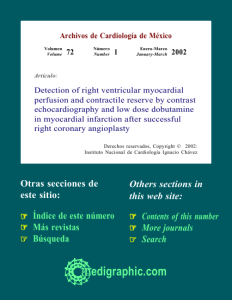
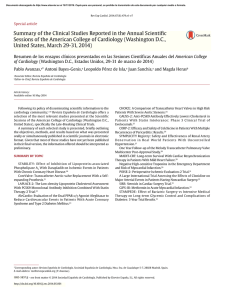
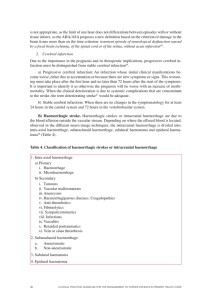
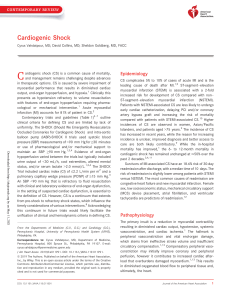
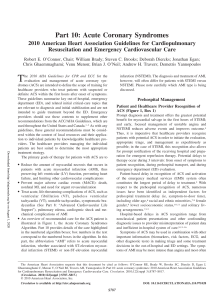
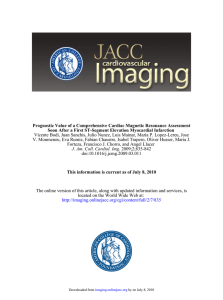
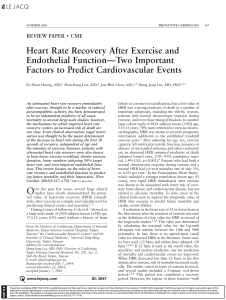
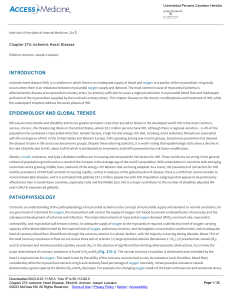
![[Fifty Studies Every Doctor Should Know] Kristopher Swiger, Joshua R. Thomas, Steven Hochman, Michael E. Hochman - 50 Studies Every Internist Should Know (2015, Oxford](http://s2.studylib.es/store/data/008781754_1-11ced48da13c047aea380eaf1a5e7474-300x300.png)
